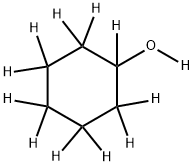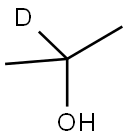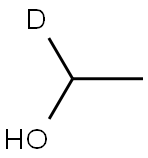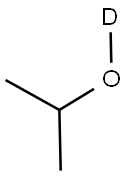CYCLOHEXANOL-D12
Synonym(s):Cyclohexyl alcohol-d12
- CAS NO.:66522-78-9
- Empirical Formula: C6H12O
- Molecular Weight: 100.16
- MDL number: MFCD00064167
- EINECS: 266-389-6
- SAFETY DATA SHEET (SDS)
- Update Date: 2025-09-29 14:31:18

What is CYCLOHEXANOL-D12?
Chemical properties
clear colorless liquid
The Uses of CYCLOHEXANOL-D12
Cyclohexanol-d12 is the deuterated analog of cyclohexane, general organic chemical solvent. It is also used as a precursor to the synthesis of nylon.
The Uses of CYCLOHEXANOL-D12
Cyclohexanol-d12 (CAS# 66522-78-9) is a useful isotopically labeled research compound.
Properties of CYCLOHEXANOL-D12
| Melting point: | 20-22 °C (lit.) |
| Boiling point: | 160-161 °C (lit.) |
| Density | 1.059 g/mL at 25 °C |
| vapor pressure | 1 mm Hg ( 21 °C) |
| refractive index | n |
| Flash point: | 154 °F |
| storage temp. | 4°C |
| solubility | Chloroform (Sparingly), Ethyl Acetate (Slightly) |
| form | Oil |
| color | Colourless |
| explosive limit | 12.25% |
| CAS DataBase Reference | 66522-78-9 |
Safety information for CYCLOHEXANOL-D12
| Signal word | Warning |
| Pictogram(s) |
 Exclamation Mark Irritant GHS07 |
| GHS Hazard Statements |
H315:Skin corrosion/irritation H335:Specific target organ toxicity, single exposure;Respiratory tract irritation |
| Precautionary Statement Codes |
P261:Avoid breathing dust/fume/gas/mist/vapours/spray. P264:Wash hands thoroughly after handling. P264:Wash skin thouroughly after handling. P270:Do not eat, drink or smoke when using this product. P301+P312:IF SWALLOWED: call a POISON CENTER or doctor/physician IF you feel unwell. P302+P352:IF ON SKIN: wash with plenty of soap and water. |
Computed Descriptors for CYCLOHEXANOL-D12
New Products
Indole Methyl Resin tert-butyl 9-methoxy-3-azaspiro[5.5]undecane-3-carboxylate Boc-His(Boc)-OH 2-CTC Resin 4-Chloro-7-tosy1-7Hpyrrolo[2,3-d]pyrimidine 5,7-Dibromo-1H-indole 2,5-dichloro-N-hydroxy-4,6-dimethylpyridine-3-carboximidamide 2,2-Dimethoxy-7-azaspiro[3.5]nonane hydrochloride 4-chloromethyl-5-methyl-1,3-dioxol-2-one (DMDO-Cl) R-2-BENZYLOXY PROPIONIC ACID 1,1’-CARBONYLDIIMIDAZOLE 1,1’-CARBONYLDI (1,2-4 TRIAZOLE) N-METHYL INDAZOLE-3-CARBOXYLIC ACID 4-((2-hydroxyethyl)thio)benzoic acid 1-(TERT-BUTOXYCARBONYL)-2-PYRROLIDINONE Methyl 6-methylnicotinate 3-Pyridineacrylic acid tert-Butyl carbazate TETRAHYDRO-2H-PYRAN-3-OL 2-((4-morpholinophenylamino) (methylthio) methylene) malononitrile 3-(4-morpholinophenylamino)-5-amino-1H-pyrazole-4-carbonitrile 2,4-dihydroxybenzaldehyde 1,3-Diethyl-1,3-Diphenylurea Methyl 2-methylquinoline-6-carboxylateRelated products of tetrahydrofuran








You may like
-
 Cyclohexanol-d12 CAS 66522-78-9View Details
Cyclohexanol-d12 CAS 66522-78-9View Details
66522-78-9 -
 Pyridine 99.5% HPLC /UV SpectroscopyView Details
Pyridine 99.5% HPLC /UV SpectroscopyView Details
110-86-1 -
 Guanine , 99%View Details
Guanine , 99%View Details
73-40-5 -
 Piperazine Spot supply, best priceView Details
Piperazine Spot supply, best priceView Details
110-85-0 -
 Dibutyl PhthalateView Details
Dibutyl PhthalateView Details
84-74-2 -
 Imidazole Spot supply, competitive priceView Details
Imidazole Spot supply, competitive priceView Details
288-32-4 -
 Octadecyl 3-(3,5-di-tert-butyl-4-hydroxyphenyl)propionate 98% (GC)View Details
Octadecyl 3-(3,5-di-tert-butyl-4-hydroxyphenyl)propionate 98% (GC)View Details
2082-79-3 -
 Thiourea 99% ARView Details
Thiourea 99% ARView Details
62-56-6
Statement: All products displayed on this website are only used for non medical purposes such as industrial applications or scientific research, and cannot be used for clinical diagnosis or treatment of humans or animals. They are not medicinal or edible.
